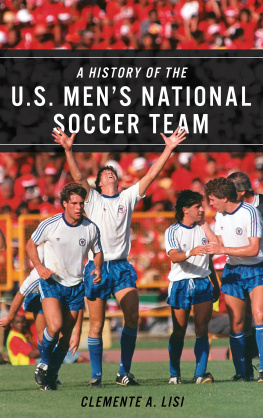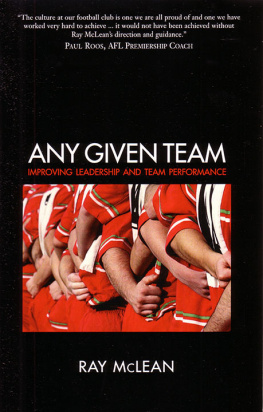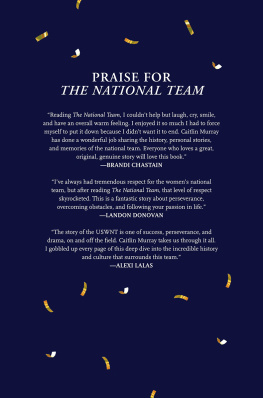A History of the U.S. Mens National Soccer Team
A History of the U.S. Mens National Soccer Team
Clemente A. Lisi
Rowman & Littlefield
Lanham Boulder New York London
Published by Rowman & Littlefield
A wholly owned subsidiary of The Rowman & Littlefield Publishing Group, Inc.
4501 Forbes Boulevard, Suite 200, Lanham, Maryland 20706
www.rowman.com
Unit A, Whitacre Mews, 26-34 Stannary Street, London SE11 4AB
Copyright 2017 by Rowman & Littlefield
All rights reserved . No part of this book may be reproduced in any form or by any electronic or mechanical means, including information storage and retrieval systems, without written permission from the publisher, except by a reviewer who may quote passages in a review.
British Library Cataloguing in Publication Information Available
Library of Congress Cataloging-in-Publication Data
Names: Lisi, Clemente Angelo, 1975 author.
Title: A history of the U.S. mens national soccer team / Clemente A. Lisi.
Other titles: History of the United States mens national soccer team
Description: Lanham, Maryland : Rowman & Littlefield, 2017. | Includes bibliographical references and index. |
Identifiers: LCCN 2017005972 (print) | LCCN 2017027865 (ebook) | ISBN 9781442277588 (electronic) | ISBN 9781442277571 (hardcover : alk. paper)
Subjects: LCSH: United States Mens National Soccer TeamHistory. | SoccerUnited StatesHistory.
Classification: LCC GV944.U5 (ebook) | LCC GV944.U5 L57 2017 (print) | DDC 796.334/630973dc23
LC record available at https://lccn.loc.gov/2017005972
 The paper used in this publication meets the minimum requirements of
The paper used in this publication meets the minimum requirements of
American National Standard for Information SciencesPermanence of Paper
for Printed Library Materials, ANSI/NISO Z39.48-1992.
Printed in the United States of America
To those who work hard every day to help soccer grow in the United States
Acknowledgments
T his book would have never been possible if not for the love and support of so many people. First of all, thank you to my wonderful wife Kate, for her unrelenting love, and to my children, Grace and Mark, who continue to make me see the world with the wonder and curiosity only a child can bring. Thanks again to my editors at Rowman & Littlefield. I have worked with them since writing my first book in 2007, and it has been a great relationship. They saw the need for soccer books long before they became fashionable. A special thanks to my editor Christen Karniski for her insight, patience, and hard work.
I would also like to take the time to thank J Hutcherson of USSoccerPlayers.com, who has given me the chance to cover American soccer for the past decade. This book would also not have been possible without the hard work and dedication of so many historians and journalists who came before me. They served as an inspiration to me throughout this process. My thanks, in particular, go to U.S. Soccer for providing me with vital statistics and Ed Farnsworth for compiling every box score of every U.S. game. His work, and that of the Society of American Soccer History, has been instrumental in keeping the history of this great game alive.
A special thank you goes to those who helped bring to life the words on these pages with their photography. I would like to single out ISI Photos, as well as Jon van Woerden for his support and generosity.
Introduction
I f there ever was a team that galvanized a nation, it has been the U.S. mens national soccer team. The 1980 Miracle on Ice hockey team gave Americans something to cheer about during the Cold War. The 1992 Dream Team showed the world U.S. basketball dominance. And the 1999 U.S. team that won the Womens World Cup highlighted the equality achieved by women in sports. But the U.S. mens soccer team has done this on a more consistent basis.
The team did it in 1990, making history after qualifying for the World Cup for the first time in 40 years. It happened again four years later, when the United States hosted the World Cup. Once again, in 2002, Americans awoke in the middle of the night to watch the team reach the World Cup quarterfinals half a world away in South Korea. Then came 2010 and 2014, when millions were enthralled by a team that was able to captivate a nation, pushing soccer more and more into the American sports mainstream. And to think, it was not until 1984 that a national team game was broadcast on television in the United States.
But this was not always the case. The national team toiled in obscurity for decades, at a time when soccer did not get mainstream media coverage. The team itself struggled to win games, playing like the chips were downand for many years they were. The Americans were the underdogs both in their own region and at the international level, going 40 years without qualifying for a World Cup, before finally breaking through in 1989. Since then, the team has been on an upswing, putting together many gritty performances, while also putting together some shocking upsets.
A History of the U.S. Mens National Soccer Team recounts some of those history-makingand other obscure, but also significantfeats. From its historic 1991 Gold Cup final victory, to its showing at the 1995 Copa America, to reaching the 2009 Confederations Cup final, the U.S. mens national soccer team has not only aided in the games growth, but also helped turn the United States into a soccer nation.
Like all my books, this one aims to both inform and entertain. Older fans will revel in the nostalgia and player profiles; younger ones will learn about tournaments and games that have long been forgotten but were nonetheless important to the teams growth. I hope this book will serve as a reference as the United States prepares for the 2018 World Cup and for years to come.
Humble Beginnings: 19161929
T he story of the U.S. mens national soccer team started in 1916, on a field in Stockholm. It was there that the Americans played their first official game against Swedena match the Americans won, 32, after accepting an invitation to play in the Scandinavian nation. The teams creation came three years after the United States Football Association (USFA) had been formed on April 5, 1913, after the official charter was signed at the Astor House Hotel in New York City. Until then, the game had been played largely on an amateur basisand had even featured teams that had represented the United Statesbut the creation of a national governing body was meant to professionalize the game, as had been done in England.
At the same time, the National Challenge Cup, a national soccer tournament for all clubs now known as the Lamar Hunt U.S. Open Cup, was played in the 19131914 season. Brooklyn Field Club won the first title, a trophy donated by Thomas Dewar, for the purpose of trying to promote the sport. Dewar, a famous Scottish whisky distiller, was a big fan of the game and had donated various trophies for sports tournaments in the United States and Great Britain. The competition was the first truly national soccer competition at a time when most leagues and tournaments were regional. It remains the oldest cup competition in the United States.
The U.S.Sweden game, part of a six-match tour, also included a trip to Norway. The USFA, the precursor to the modern-day United States Soccer Federation (or as it is commonly known, U.S. Soccer), had been created in 1913, with the task of overseeing the sport throughout the country. Soccer was growing before World War I. The American Soccer League (ASL), which formed in 1921, was the first professional league in the United States. The ASL attracted players countrywideand even from Europeand helped boost the games popularity at a time when baseball and horse racing were the most beloved spectator sports. The team featured captain Thomas Swords, a forward who played for the Fall River Rovers of the New England League. The first national team was comprised primarily of players from the Northeast, recruited for the purpose of playing for what was called the All-American Soccer Football Team. Swords, whose energetic style and rugged athleticism typified the American game at the time, would go on to score the first-ever goal for the United States. Following the tour, he would never again feature for the United States.
Next page











 The paper used in this publication meets the minimum requirements of
The paper used in this publication meets the minimum requirements of